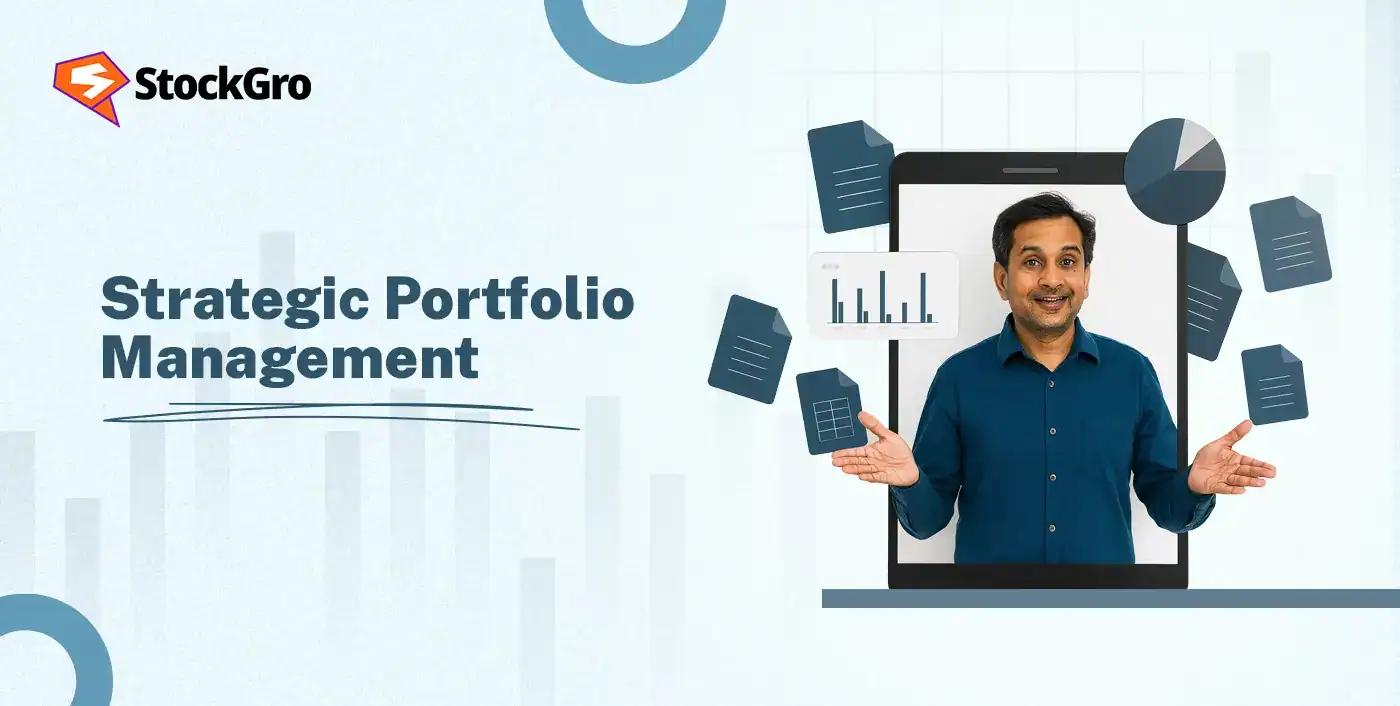
Without a structured approach, trading and investment decisions often become scattered, leading to weak diversification, inconsistent risk handling and less predictable outcomes. Studies show that over 85% of active day traders fail in their first year mainly because of poor risk management. This shows how important it is to have a clear, structured approach. Strategic portfolio management helps create that structure by planning how money is divided, risks are handled, and results are tracked. It ensures every trade or investment supports your overall goal instead of working on its own. In this blog, we explain how strategic portfolio management can bring more clarity and discipline to your trading and investment decisions.
What Is Strategic Portfolio Management?
Strategic portfolio management (SPM) is a business process. It helps an organisation select the right projects and initiatives to focus on. It connects the company’s main strategy with its execution. The goal is to make sure that all work, resources, and funds are used on initiatives that help the organisation achieve its strategic objectives. This approach provides a complete view across all work, helping leaders make better decisions that drive business value.
Why Strategic Portfolio Management Matters for Investors
Strategic portfolio management is important because it connects an investor’s or company’s projects directly to their main goals. This alignment is the reason for the importance of portfolio management. It moves beyond managing individual projects to seeing the big picture. This approach ensures that all efforts and funds are spent on the right things. The main benefits include:
- Making sure that investments and projects support the overall business strategy.
- Improving how limited resources, like people and money, are used.
- Increasing the success rates of projects by choosing the right ones.
- Allowing leaders to make better, faster decisions with clear information.
- Providing more transparency for everyone involved.
- Helping the organisation respond to market changes or disruptions more quickly.
All in all, it helps to get the most value from the organisation’s investments. This same focus applies to Strategic portfolio management in trading, where every move must support a central strategy.
Key Components of Strategic Portfolio Management
A strong portfolio strategy consists of several key components. These components include:
- Strategic alignment: This is the core component. It deals with creating a direct link between the investor’s high-level financial goals and the individual investments selected for the portfolio.
- Financial management: This incorporates planning, budgeting, and forecasting the costs and prospective returns of investments, ensuring they align with the overall financial plan.
- Capital planning: This component focuses on deciding which long-term or high-cost investments to fund, based on their likely to deliver value.
- Risk management: This is the process of identifying, assessing, and preparing for possible dangers or losses within the portfolio.
- Demand management: This covers creating a central place to gather and review all future investment ideas before they are approved.
- Resource management: This refers to the efficient allocation of capital and other resources to the prioritised investments.
- Performance monitoring: This is the ongoing tracking of the portfolio’s health and progress against the set financial goals.
Types of Strategic Portfolio Approaches
The principles of strategic management can be applied through several different types of portfolio management. These approaches help guide how a portfolio is managed, such as:
- Active management: This approach entails making regular, hands-on decisions to manage the portfolio. It requires constantly monitoring performance and making frequent adjustments to projects or assets to optimise results and adapt to changes.
- Passive management: This is a more hands-off approach. It includes setting up a portfolio based on a long-term strategy, such as a specific strategic asset allocation strategy, and then making minimal changes, allowing it to perform without frequent intervention.
- Dynamic planning: This approach focuses on flexibility and allows an organisation to adapt its strategies in real time. It encompasses periodically reassessing plans and reprioritising investments in response to new information or market shifts.
- Capital planning: This approach is focused on managing an organisation’s long-term, large-scale investments. It provides a clear view of financial resources to help prioritise spending based on emerging returns and importance.
Active vs Passive Strategic Portfolio Management
Portfolio management can be viewed as either adaptive (active) or static (passive). The core difference between active and passive portfolio management have been discussed below.
| Feature | Active (adaptive) management | Passive (static) management |
| Approach | Based on continuous planning and adjustment. | A fixed plan is set and executed with few changes. |
| Flexibility | Highly flexible; can pivot and reprioritise as needed. | Rigid; lacks the versatility to respond to change. |
| Decision-making | Uses real-time data to make fast, informed decisions. | Often slowed by outdated information and manual processes. |
| Data | Relies on a single source of truth for clear visibility. | Often suffers from fragmented data and information silos. |
| Goal | To continuously optimise the portfolio for value. | To complete projects as originally planned. |
Steps to Build a Strategic Portfolio
Building a strategic portfolio follows a clear, multi-step process. The main steps are as follows:
- Define strategic goals: The first step is to clearly define what the portfolio needs to achieve. This includes setting clear, measurable financial objectives that will guide all other decisions.
- Inventory and identify: Gather a complete list of all current investments and any promising new investments, trades, or projects being considered.
- Analyse and evaluate: Review each potential investment. Score them based on how well they align with the strategic goals defined in the first step. Assess their potential value, cost, and risk.
- Prioritise and align: Use the analysis to rank the investments. Decide which ones to fund and which to reject or put on hold. This prioritisation is a key part of a Strategic asset allocation strategy.
- Optimise and manage: From the prioritised list, select the final mix of investments that best balances risk and return. This is where Strategic portfolio management in investment is applied by actively managing the allocation of capital.
- Monitor and adjust: Once the portfolio is built, it must be monitored continuously. This covers tracking performance and making adjustments as needed to keep the portfolio aligned with goals and to respond to changes in the market.
Common Mistakes Investors Make in Portfolio Strategy
Investors often make common mistakes when they do not have a formal strategy. These mistakes can reduce returns and increase risk, such as:
- Poor alignment: This is a primary mistake. It involves choosing investments based on emotion, popularity, or as “pet projects” that do not actually support the investor’s main financial goals.
- Having unclear objectives: Without well-defined and clearly communicated goals, it is impossible to make good priority decisions.
- Fragmented data: Using different, disconnected tools or spreadsheets to track investments. This leads to information silos, making it hard to get a clear, single view of the total portfolio.
- Slow or bad decisions: Relying on manual processes and scattered information slows down decision-making. This prevents an investor from reacting quickly to market changes.
- Failing to adapt the plan: Sticking to a rigid, static plan and failing to review or adapt it. A good strategy must be flexible enough to change when new information becomes available.
- Lacking an objective ranking system: Failing to use an objective process to score and rank investments. This can lead to capital being spent on low-value assets.
Conclusion
In the end, strategic portfolio management helps you plan your investments instead of just reacting to the market. It gives you the discipline to build a stronger portfolio. This structured approach helps you handle market ups and downs and stay focused on your long-term money goals, rather than getting distracted by daily changes.
FAQs
Strategic portfolio management in stock market investing means creating a structured plan to select, balance, and monitor investments. It aligns your asset choices and trading decisions with long-term financial goals, using clear rules for asset allocation, risk management, and performance tracking to maximise returns and reduce surprises.
Strategic portfolio management in trading is the disciplined process of ensuring every trade or position fits the overall investment plan. It keeps you focused on your big-picture goals like risk limits, sector allocation, or target returns by guiding which assets to buy, hold, or sell based on a defined strategy.
Regular portfolio management may address only day-to-day buying and selling without connecting investments to higher-level goals. Strategic portfolio management goes further: it aligns every asset with long-term objectives, using analysis and structured reviews to optimise returns, risk and adapt to changing situations.
Strategic asset allocation strategy involves setting and maintaining fixed target percentages for each asset class (like equities, bonds, and cash). It requires periodic rebalancing to those targets regardless of market trends helping investors stay disciplined, manage risk, and ensure diversification over the long term.
Yes, AI tools like Stoxo can help enormously in strategic portfolio management by analysing large datasets, suggesting optimal allocations, identifying hidden risks, and automating rebalancing. They provide real-time insights that help investors stick to their strategy, respond quickly to change, and lower emotional mistakes.
Common mistakes include vague goals, emotional investing, lack of diversification, holding on to poor performers, ignoring rebalancing, and failing to adapt the plan as circumstances change. Others rely on manual processes or disconnected data, leading to slow reactions and poor risk management.

